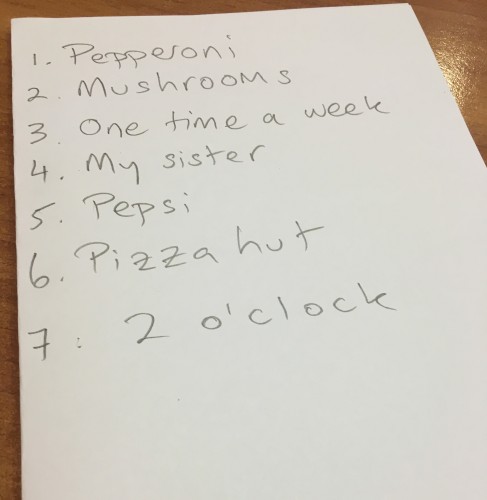No prep? No problem?
Robert Miles Way back in the distant past, around the turn of the century, I did my DELTA part time at King’s College London. One of our tutors was John Shepheard, author of the Anti-Grammar Grammar Book (with Nick Hall) among others.
Way back in the distant past, around the turn of the century, I did my DELTA part time at King’s College London. One of our tutors was John Shepheard, author of the Anti-Grammar Grammar Book (with Nick Hall) among others.
One thing he used to do before every input session was give us a lesson that needed no prep, minimal materials and was ideal for “when you are walking upstairs to class realizing you haven’t prepared anything”!
Now, of course I know that none of us ever walks to class with this going through our head, leaving college on Thursday with the whole of the next week planned out in minute detail. However, on the off chance you might be called in to cover, or need to come up something off the cuff, I thought I’d share one of my favourites from that time.
Instructions
Right. Make sure each student has a piece of paper and a writing implement, or they can use their iPads, Smart phones or even the back of their hand. Tell the students the following…
- On your piece of paper, write the numbers from 1 to 7 down the left-hand side.
- I am going to ask you seven questions. Write the answer to the question. Do NOT write the question. (Concept check here as you’ll get all sorts happening otherwise!)
 What’s your favourite type of pizza? TWO. What pizza topping do you hate? THREE. How often do you eat pizza? FOUR. Who do you eat pizza with? FIVE: What do you normally drink with pizza? SIX: Which is the best pizza restaurant in your town. SEVEN, Imagine the pizza is a clock. What time do you start eating? (OK- last one is a bit leftfield…)
What’s your favourite type of pizza? TWO. What pizza topping do you hate? THREE. How often do you eat pizza? FOUR. Who do you eat pizza with? FIVE: What do you normally drink with pizza? SIX: Which is the best pizza restaurant in your town. SEVEN, Imagine the pizza is a clock. What time do you start eating? (OK- last one is a bit leftfield…)
- In pairs, students discuss / compare their answers.
- What do you have on your paper? (ANSWERS) How many? (SEVEN) Do you have questions? (NO). OK, good – I now want you to write the questions as I asked them.
- Students now work together to recreate the questions.
- Check as a class – you can either reorganise the class into new pairs or groups for them to ask and answer the questions, or get them to ask you directly, up to you.
When I check, I insist that the questions are exactly as I asked them – “What’s you favourite type of pizza?”, not “What pizza do you like?”. Lots of grammar to exploit here.
- FOLLOW UP: I ask the pairs to think of another normal activity like eating pizzas. Once they come up with something, e.g. coming to college, using your phone, surfing the net etc, I get them to write 5 questions to ask their colleagues, and so on. I also sometimes follow up with an email / paragraph putting their answers into sentences.

Mm. Two o’clock please!
Varieties?
Obviously, this is easy to adapt. You can:
- target grammar forms with the questions you ask, for example
- reduce the number of questions for weaker groups, it’s up to you, or
- change the topic
– all you need is somewhere for the students to write and time to think of seven questions!
Thanks John!
This could be adapted into an adobe voice style presentation as well, having the students write or say the question and then write or say the answer with an image as a quick tech-friendly output. Having the recorded voice is nice because you can play the presentations for the class and have them correct the grammar as they watch.
Definitely cover material. You could make up a few and leave them on your g:drive. Then you'd just have to share the link and the cover teacher would be all ready to go. I like the minimalist nature of this as well. It reminded me of Scott Thornbury's Dogme approach, which is similarly minimalist in nature.